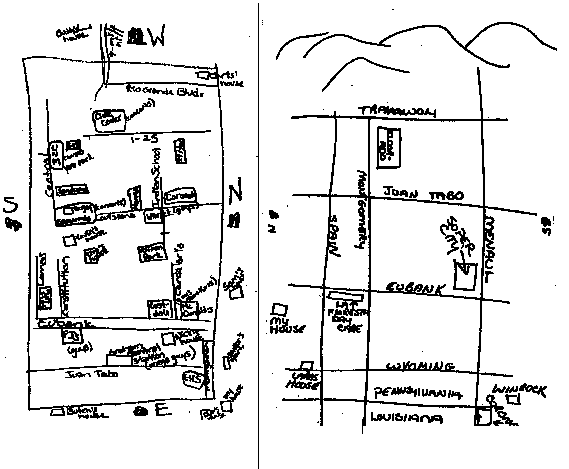Think about various and widely differing sections of the city (the rural South Valley, urban Downtown, the green Tijeras Canyon, desert-like bluff of the West Mesa, the semi rural North Valley, or the rugged Foothills of the Northeast Heights). In which of these places would you most like to live? Write a story telling why you like the place you selected, and how it makes you feel to be in that kind of setting.
Read Robert Frost's poem, "Fences." Discuss with classmates. Why do people build fences? How do you feel about it?
Set up a photographic exhibit of pictures on the subject, What I Like and Dislike about My Neighborhood.
Arrange a buddy class from a different school in a different part of Albuquerque. Students can meet each other on jointly arranged trips, converse through email, visit each other's schools for special events, correspond, exchange photographs, have athletic events together, and set up discussion forums or seminars. Try to select a school in parts of the city students never, or seldom, visit. At the end of the year, discuss how this experience may have led to a better understanding of other places and people in Albuquerque.
Make a pictorial cognitive map of the parts of Albuquerque you know. Compare with other students in the class, and discuss the similarities and differences.

Leigh Ann Hatten, Eldorado High School Jenni Richards, Eldorado High School
Grasses
- Blue Grama Buffalograss Indian Rice Grass
- Saltgrass Sand Dropseed Side-Oats Grama
- Six Weeks Grama Western Wheatgrass
Shrubs
- Apache Plume (Fallugia paradoxa) Beargrass ((Nolina)
- Big Leaf Sage (Artemisia tridentata ) Bird of Paradise ((Caesalipinia gilliesii)
- Broom Dahlea (Dalea) Bush Honeysuckle (Lonicera tatarica) -
- Cactus (Cactus) - many varieties Not very drought tolerant
- Chamisa (Chrysothamnus nauseosus) Cliffrose (Cowania mexicana)
- Common Juniper (Juniperus communis) - Creosotebush (Larreu tridentata)
- female only Fourwing Saltbush (Atriplex canescens)
- Mondell Pine (Pinus elderna) Mountain Mahogany (Cercocarpus
- Mariola (Parthenium incanum montanus) - needs water in winter
- Mormon Tea (Ephedra) Pampas Grass (Cortaderia)
- Red Cedar (Juniperus) - female only New Mexico Locust (Robinia neo-mexicana)
- Snakeweed (Gutierrizia) Silktassel Tree (Garrya fremonti) -
- Skunkbush (Rhus trilubata) Siberian Caragana (Caragnea)
- Sotol (Dasylirion wheeleri) - not in severe Silverberry (Elaeagnus pungens)
- winter Silverking Artemisia (Artemisia -
- Spanish Broom (Genista hispanica) - low water eudoviciana)
- Soapberry (Sapindus suponaria) Threeleaf Sumac (Rhus trilobata)
- Winterfat (Ceratoides lanata) Wolfberry (Lycium pallidum)
- Yucca (Yucca)
Trees
- Alligator Juniper (Juniperis deppeana) - female only Piñon Pine (Pinus edulis) - needs winter water
- Desert Willow (Chilopsis linearis) 0ne-Seed Juniper (Juniperus monosperma) - female
- Rocky Mountain Juniper (Juniperis scopulorum) Rio Grande Cottonwood (Populus) - needs ground -female only water
- Salt Cedar (Tamarix pentandra) Russian Olive (Elaeagnus angistifolia) - needs ground Mcsquite (Prosopis) -some not hardy this far north water
Information taken from Southwest Landscaping with Native Plants, Judith Phillips, Museum of New Mexico, 1987 and NMSU Cooperative Extension Service, Native Shrubs in Southwest Landscapes, 400 H-4.
Native Shrubs
Recommended For Southwest Landscapes
Adapted from native Shrubs in Southwest Landscapes by M. Douglas Bryant, Extension Horticulture Specialist, NMSU.
Apache Plume
Six to eight feet, widely branched shrub. Numerous white flowers as large as apple blossoms, followed by cluster of reddish-tinged plumes. Thrives with abundant water, but endures extreme drought. Native to 6,000-7,000 foot elevation, but grows in canyons and on mesas.
Silktassel
This wood shrub is a member of the Garrya family. It has regular branching and reddish-brown or gray bark, with leathery oblong or oval leaves and very light fruit. Height varies from one to eight feet.
Bird Of Paradise
A decorative shrub with green stems six to eight feet high, and large compounded leaves containing small leaflets. Large flowers with yellow petals and long red stamens and pistils. The fruit, a large flat pod, explodes when dry and scatters its seeds. The plant is ill-smelling.
Chamiso
This very common plant of the dry mesas, plains, and arroyos is often mistakenly called sage. It is a heavily branched, gray shrub with narrow, small leaves and dense panicles of one seeded fruits. Flowers appear in mid-summer. Green fruits, which later turn yellowish-brown, appear in mid-August and stay on into the winter. The plant is also called Four-Winged Salt Brush.
Mountain Mahogany
Widely branching small hardwood shrubs with small, inconspicuous, petal-less flowers. Seed has a long, spiral plume.
Oregon Grape
Used as a ground cover, this plant has woody stems five or six inches long, and compound leaves similar to those of holly. Leaves turn orange-red in the fall. The plant bears berries about the size and color of wild grapes.
Creosote Bush
Named because of the creosote-like odor given off when wet. This shrub is a rapidly growing, very attractive plant with a dark green color. It is an evergreen, and the leaves have a resinous coating. It requires large amounts of water to get started and to grow well. Flowers are small and yellow.
Rabbit Brush
Shrubby perennial, erect or spreading with narrow leaves and small heads of yellow flowers.
Lemonade Berry
Shiny, leathery evergreen leaves are divided into three leaflets. Dense clusters of yellow flowers are followed by a sticky, bright orange-red berry which makes a lemonade-like drink. The shrub grows eight to ten feet.
Desert Willow
Although this plant usually grows as a shrub from five to fifteen feet high, it can be pruned to form a tree. It is well adapted to dry situations, and is found in arroyos and the foothills. Its leaves are long and willow-like, and it has profuse large white or purplish flowers. It is easily transplanted.
(Up to Section IV, Back to Additional Activities 5, On to Eye Opener Worksheet 6)